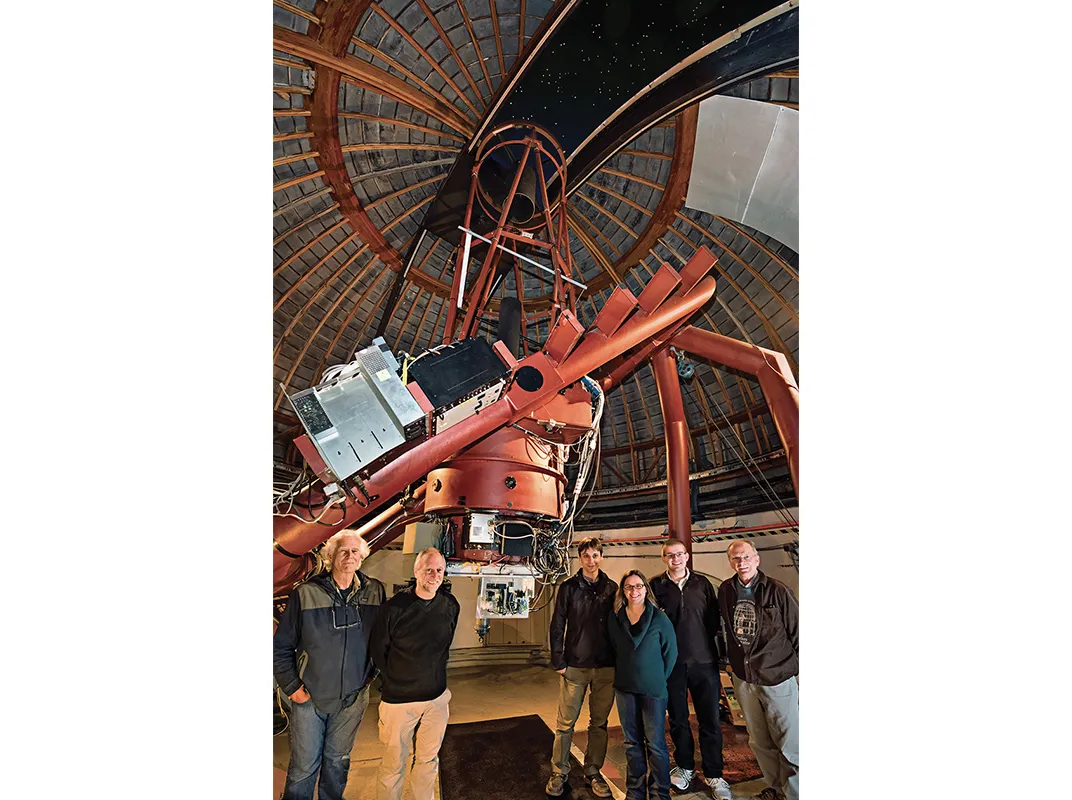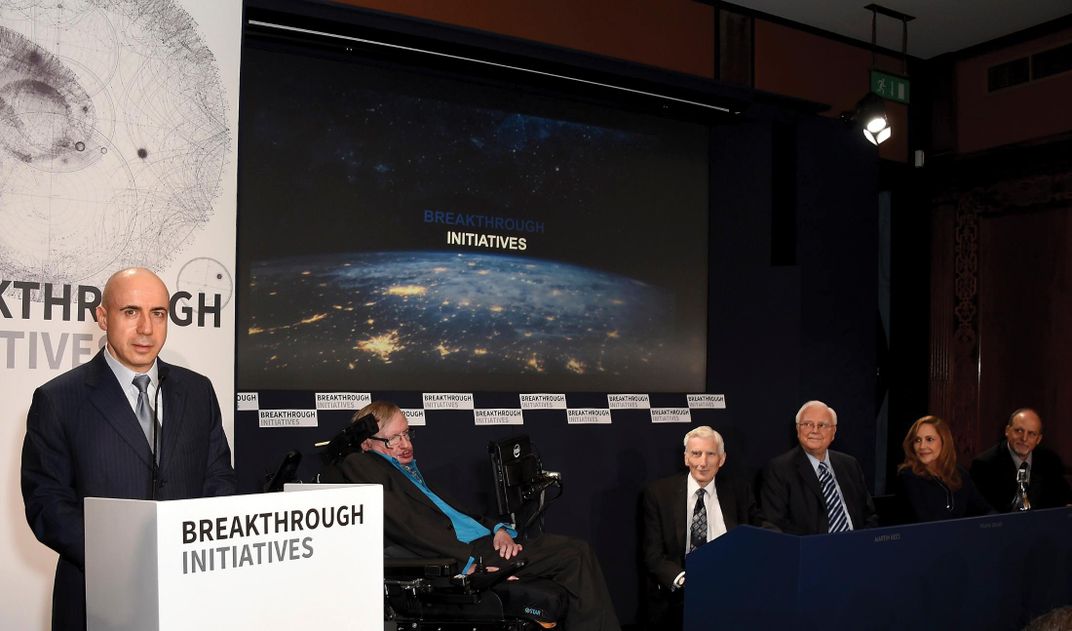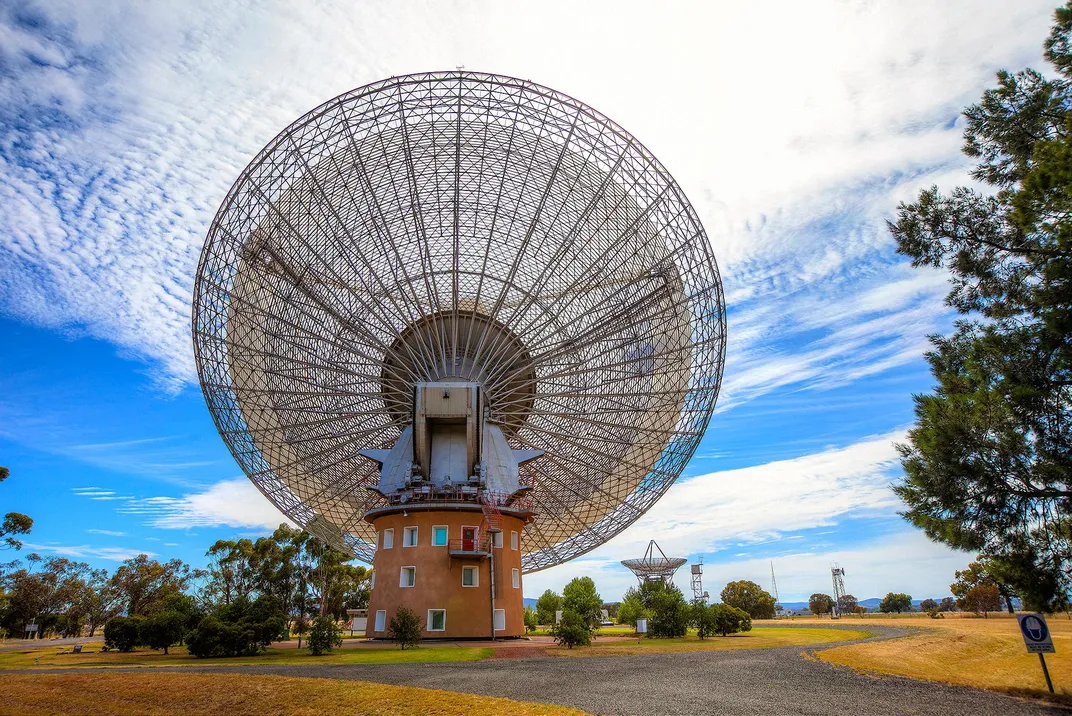SETI Gets an Upgrade
If we broaden our search, will we hear aliens? $100 million says yes.
/https://tf-cmsv2-smithsonianmag-media.s3.amazonaws.com/filer/e6/e0/e6e05bbb-7884-46f5-9881-5650324e4e92/02c_jj2016_telescopegreenbankatnight_live-wr2.jpg)
Dan Werthimer doesn’t mean to be rude, but he’s getting ready to eavesdrop on the neighbors.
For decades, astronomers have been listening for messages sent to us—a “Hello, is anyone out there?” signal from intelligent aliens. But now Werthimer is about to get nosier; his team at the University of California at Berkeley is conducting the first search for communities on other worlds that are speaking to one another—between planets and even across star systems. And to do it, he has two of the world’s largest radio telescopes and support from a planet‑hunting optical telescope.
Thanks to a new initiative announced last July, Werthimer’s team will begin searching for extraterrestrial civilizations, using instruments with greater sensitivity and scanning across a wider range of frequencies than any SETI (search for extraterrestrial intelligence) project to date. Called Breakthrough Listen, it began earlier this year and will continue for a decade at a price tag of $100 million. “It’s a lot of money, a lot of telescope time,” says Werthimer. “We’ll be able to look at a hundred billion radio channels simultaneously. A big problem in SETI is we don’t know on what frequency ET might be transmitting, so the more channels you can listen to, the better chance you have of finding” a communication.
“It’s an incredibly exciting time scientifically,” adds Werthimer’s colleague Andrew Siemion, director of Berkeley’s SETI Research Center and another Breakthrough Listen leader. “Something like one in five stars has an Earth-like planet…. And our ability to look for different kinds of signals from intelligent civilizations on those planets is growing by leaps and bounds.”

Even with improvements in technology, though, SETI has remained a tiny area within the field of radio astronomy. “In the entire world, there are probably fewer than 12 people who do full-time SETI research,” according to Seth Shostak, a senior astronomer for the SETI Institute in nearby Mountain View.
But that small cadre of researchers, with the help of a few dozen part-time SETI dabblers, has plowed through an impressive number of projects. They have scanned the skies at radio and optical wavelengths for intentional messages from other civilizations. Researchers have picked through data from NASA’s planet-hunting Kepler space telescope for evidence of vast architecture eclipsing part of a star’s light. (The public release of one star’s odd light curve last year generated a round of speculation about alien mega-structures. Sadly, followup observations have suggested that the more likely explanation is a swarm of comets.) And they’ve looked for super-civilizations producing copious amounts of waste heat in the form of infrared energy. And the ideas never stop coming: There is a proposal to search for alien probes and artifacts in the solar system (possible payoffs but expensive) and another to listen for signals in beams of neutrinos or the recently discovered gravitational waves (far beyond current technology).
“The bottleneck is never a lack of ideas,” says Shostak. “The problem has always been funding.”
From the first search for extraterrestrial signals—Frank Drake’s Project Ozma in 1960—SETI has struggled to be taken seriously by traditional funding agencies. Modest NASA studies in the 1970s and 1980s were criticized by the U.S. Congress; in 1993, legislators axed what was meant to be NASA’s long-term sky survey after just a year. Since then the field has survived, barely, primarily on private funding sources.
Then last summer, Russian billionaire Yuri Milner announced he would foot the bill for the biggest alien hunt in history. “In the 20th century, we stepped out from our planet—to space, to the moon, to the solar system,” Milner said at a press conference for Breakthrough Listen last summer. “In the 21st century, we will find out about life on a galactic scale…. It is time to open our eyes, our ears, and our minds to the cosmos.” Among the luminaries endorsing Milner’s project that day was astrophysicist Stephen Hawking.
Milner, named after first-human-in-space Yuri Gagarin, was studying physics at Moscow University in the 1980s when the entrepreneurial spirit first hit him. He started buying American-made personal computers and reselling them in local shops, then ventured to the United States to get an MBA. After briefly working at the World Bank, he returned to Russia and began investing in businesses, parlaying the purchase of a small factory into the takeover of the country’s largest Internet company. With that move as an entry to the world of technology, Milner organized a venture capital fund, DST Global, which became an early investor in Facebook, then Twitter, Groupon, and Airbnb, along with major companies in India and China. According to Forbes, by the end of 2015 Milner amassed a net worth of $3.3 billion. In happy news for non-billionaire scientists, Milner started a foundation in 2012 that awards three $3 million prizes annually—the largest academic prize in the world—for achievements in fundamental physics, life sciences, and mathematics.
He also refuses to give interviews about his latest investment, so we can get a sense of his intentions only from the people now running the Breakthrough Listen project. “He studied physics, he studied the same kind of books in school that I did, so he knows a lot about SETI,” says Werthimer. “He really appreciates all the subtle nuances, and he asks a lot of great questions. He knows the chances that we might find something are slim. But he speaks about this in the long term. He’s in it for the long haul.”

Werthimer was already in it for the long haul—he’s been working on SETI for decades, although his original love was the hardware, rather than the research. He’s been a tech junkie since his school days, when he joined the Homebrew Computer Club in California, where his fellow members included Apple founders Steve Jobs and Steve Wozniak. “We were kind of messing around in our basements, and we made the very first desktop,” Werthimer says. “Everybody in that club got filthy rich except for me, because I wanted to use the computers to do astronomy. But I got really good at computing. I built a lot of cool machines that were in some ways better than the Apple, but I never thought about selling them.”
Werthimer began to build instruments that collect and analyze radio signals from space, and eventually started SETI@Home in 1999, a program that harnesses the background processing power of any computer it’s installed on to help sift through portions of the massive amounts of data from the Arecibo Observatory in Puerto Rico. And although his work hasn’t revealed any alien civilizations, Werthimer isn’t bothered by the silence. “I wouldn’t be in this field if I were not an optimist,” he says. “We’ve covered maybe a billionth of the parameter space. We can rule out super-civilizations that want to conquer the galaxy”—whew—“but we can’t rule out civilizations like ours.”
Siemion too developed an early interest in science and technology. “I did a report when I was in third grade on a book by Stephen Hawking, A Brief History of Time,” he says. “When I got to Berkeley I was looking over possible research opportunities, and I discovered that there was a SETI group. I had an ‘aha’ moment—I knew immediately that that’s what I would do.”
Siemion led his first SETI project while he was still a graduate student. He got the idea in 2010, while he was attending a meeting at the Robert C. Byrd Green Bank Telescope in West Virginia to commemorate the 50th anniversary of Project Ozma. Attendees were re-creating Ozma, which originally used a small radio antenna at the Green Bank location, with the observatory’s new 300-foot-diameter Green Bank Telescope, the largest fully steerable radio telescope in the world. While Ozma took about 150 hours of telescope time, the re-creation required only a few seconds to scan the same amount of sky.
“I started thinking: Why not do some real SETI with the telescope,” Siemion says. “On the plane back to San Francisco, I met in the aisle with a few other people, and we decided to write a proposal.” The idea was to look at star systems in which the Kepler space telescope had discovered planets. “We actually received not the best grade from the time allocation committee at Green Bank,” he says. “They gave us a C, because I think they were a little bit suspicious about whether we would actually be able to do it, but luckily, even though it wasn’t highly ranked, we still got the time.”
Breakthrough Listen will take advantage of the data from Siemion’s work with Green Bank, but more importantly, it comes at a crucial time for the observatory. Constructed in a valley in the West Virginia mountains, the Green Bank Telescope opened in 2000 as part of the National Radio Astronomy Observatory. NRAO is funded by the National Science Foundation and runs several facilities, including the Very Large Array in New Mexico and the Atacama Large Millimeter/Submillimeter Array, or ALMA, in Chile (“The Universe’s Baby Boom,” Aug. 2013). But in 2012, NSF issued a report on the next 10 years of astronomy research that recommended pulling Green Bank’s funding by 2017, because some of its research abilities are duplicated at larger facilities like the VLA and Arecibo Observatory. Now SETI—usually the research area struggling for funding—has come along with Breakthrough Listen at just the right moment, providing a reason and the means to keep the telescope operating while its staff looks for additional funding.

One of Green Bank’s advantages is that it’s cocooned in the 13,000-square-mile National Radio Quiet Zone, where radio transmitters, cellphone towers, wifi networks, and other technology are limited by state and federal regulations. Scientists there would have an easier time determining if a signal in their observations is a message from another planet rather than a local teenager’s text. “One of the hardest things to do is tease out a signal from another civilization in the radio observations,” says Karen O’Neil, the Green Bank Observatory site director. “There are a lot of repeating patterns, but they’re all man-made.”
Green Bank’s receivers are so sensitive they can detect the crackle of spark plugs in a gasoline-powered engine, so only diesel vehicles are allowed within a mile of the dish. The microwave oven in the observatory’s cafeteria sits inside a shielded box, and once the telescope even picked up interference from a small current generated by a wet dog lying down on an old heating pad. Staff members drive around in a pickup truck equipped with scanning equipment to track down stray electromagnetic signals, and sometimes lend a hand to help repair or replace offending devices in nearby businesses and homes.
SETI is using some of the project funding to expand Green Bank’s computer capabilities far beyond those of any previous radio SETI project. The system will be able to process and store as much data in a single day as existing projects do in a year or more. Then it’s sent out to the SETI team at Berkeley and SETI@Home volunteers for analysis. The extra processing and storage capabilities are necessary because Breakthrough Listen will scan billions of radio channels between 1 and 10 gigahertz. Earlier surveys have been able to scan no more than a few hundred million channels at a time, with about half the spectral range. “We probably have a trillion times better capabilities today than when I started 40 years ago,” says Werthimer.
That sensitivity should allow the telescopes to pick up intelligent signals not meant for us, something that couldn’t have been done before the Kepler mission provided astronomers with exoplanet locations. “There’s speculation that an advanced civilization might colonize another planet in its own solar system, like we might do with Mars,” says Werthimer. “They might send messages back and forth between planets, and we could pick up the signals when they line up with Earth.” In addition to the nearest million stars to Earth, the SETI group will monitor the densely packed center of the Milky Way galaxy, about 27,000 light-years away. “Our solar system is about five billion years old,” says Werthimer. “Some stars are 10 billion years old, so there could be some very advanced civilizations out there.” And finally, Breakthrough Listen will stretch its search out even farther, to 100 nearby galaxies where super-civilizations might be blasting messages between solar systems.

While the Green Bank Telescope searches in the northern hemisphere, Breakthrough Listen will use the Parkes Telescope near Sydney, Australia, to search the southern sky. The 210-foot movable dish is best known for transmitting most of the Apollo 11 moon landing video for the worldwide television broadcast (the event was fictionalized in the 2000 movie The Dish). The project will use about 20 percent of the observing time on each telescope, a jump from the few dozen cumulative hours SETI usually gets annually to thousands of hours.
The third facility SETI is using will look instead of listen. The Automated Planet Finder, a 96-inch optical telescope at Lick Observatory, outside San Jose, California, will devote 10 percent of its time to searching for interstellar lasers. “If we took our own highest-powered lasers and paired them with our largest telescopes, we could send a beam that would outshine the sun by a factor of 10 at a distance of 1,000 light-years,” says Siemion. “Perhaps other civilizations are doing that to contact other civilizations, or to transmit a large amount of information.” It would be the equivalent of a Galaxy Wide Web.

Of course, not everyone is optimistic about the chances of Breakthrough Listen or any other SETI project finding evidence of neighboring civilizations, but not necessarily because they don’t believe in aliens. “Listening for intentional messages seems like a lost cause,” says Paul Davies, a researcher at Arizona State University and author of The Eerie Silence, a book that posits that current searches for intelligent life are flawed. “I’ve argued that we should be looking for other things: beacons, or probes, or alien artifacts in our own solar system. We have no idea how a super-civilization would manifest itself. It could be genetic—we could find signs in terrestrial biology…. There’s a good chance we might be alone in the universe. So we should search, but we shouldn’t spend a lot of money on it.”
Even Werthimer doesn’t expect to hear from extraterrestrials anytime soon. “I’m optimistic in the long run,” he says. “We Earthlings are a young, emerging civilization. We’re just getting in the game, so a thorough search will take a while.... We probably won’t see anything in the next 10 years, so we’ll have to devise a new plan after that. Maybe, if the trend in computing power keeps going, we’ll find ET in 30 years.”
In the meantime, let the eavesdropping begin.
